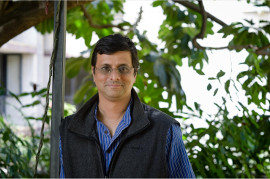B.Tech (Electrical Engineering)
Hawkmoths generally vibrate their wings for few minutes, to warm the muscles before a flight. But, when the bristles on the head of a hawkmoth are stimulated, the moths immediately take off and fly for a short duration and land. I record the electrical activity of these sensory bristles to any mechanical stimulus (touch/airflow) to understand, what aspect of the stimulus do these bristles neurons translate into spikes. This study helps understand part of the bigger question "How do moths coordinate various parts of their body for flight?"

LM Chinmayee
chinmayeelm at ncbs dot res dot in
Brain, the most complex organ of our body that controls our movements, emotions, sleep, dreams, imaginations and our perception of the world, fascinated me a lot ever since my school days. Electrical Engineering was an inevitable but helpful detour from my goal to pursue neuroscience. After engineering, a year's computational work in Dr.Rishikesh Narayanan's lab on the short term synaptic plasticity in neurons taught me about functioning of neurons from channel level to network level. With a deepened interest in neuroscience, I joined NCBS. What caught my interest more than anythings else, were insects and neural basis of their behavior. How do tiny insects perform better than us in many aspects?! How do they perceive their world in their tiny brains? The nervous system of insects intrigued me, as they perform a plethora of actions and behaviours with a very limited set of neurons (~1 lakh in moths) compared to us (8.6×1010 ). This lab was a perfect for me with fun loving people who are enthusiastic about science and discussion about every topic from food, language, music to science, history, philosophy and what not!
Besides research I am pursuing vocal Indian classical music (specifically Dhrupad). I love setting up telescope and star-gazing, cycling, trekking and of course, reading books.



